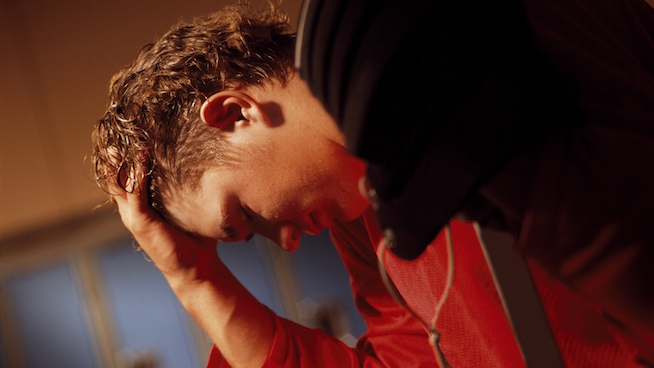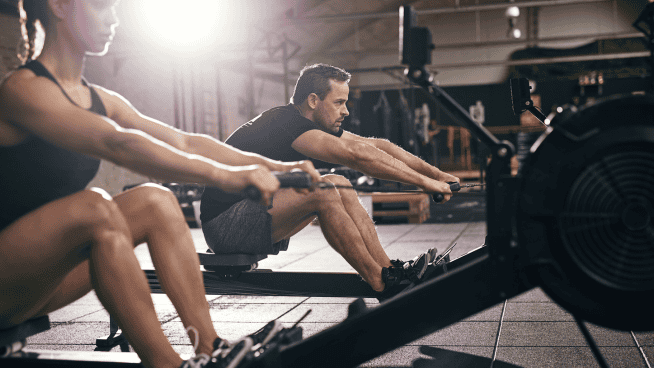3 Exercises to Prepare For Ruck March
![]()
Ruck marches are a required part of military training. They are also becoming a popular fitness trend. I personally go for a ruck march every week or two. They give me an appreciation of what my military athletes go through during physical training, and they help to build strength and toughness for obstacle course racing.
To prepare for long rucks and reduce the risk of injury require more than just rucking. Running alone places an estimated three times your bodyweight force on your knees. With this in mind, what do you think is the effect of adding a 35-pound pack? And what are the consequences of sloppy form and compensation when you get tired?
Besides loss of performance, musculoskeletal injuries, especially to the knees and back, are associated with ruck marches and load carries. Unfortunately, many recruits enter basic training without the levels of physical conditioning necessary to manage the demands of ruck marches and other basic training components.
Training the movement patterns and strengthening supporting muscles lessen impact forces at the knee. This can only be done through a comprehensive strength and conditioning program.
Below are three excellent exercises to prepare for successful ruck march training.
Back Squat + Lunge Complex

Purpose: Strengthen and stabilize muscles and movement patterns for ruck marches. Changing from a Squat to a Lunge adds stabilization under a controlled environment. Both the Squat and Lunge strengthen your ruck march muscles. Bonus: getting strong and stable enough in case you have to bend down to fix your shoelace or pick something up, for example.
How To: Perform 2 Squats and immediately perform 2 Walking Lunges. Take your time, especially when transitioning from the Squat to the Lunge. Ensure you are stable and that your hips and knees are in line. I prefer a sandbag, but you can use a pack or a weighted vest.
Slowly progress to a weight 2x what you will be rucking with. I recommend a 10% increase per week.
Prerequisites: You must have a good Back Squat and a Walking Lunge before performing this drill. It should be challenging but not impossible. If your form is compromised, this exercise complex will increase the likelihood of injury and reduce your performance instead of the opposite. Start with the Squat only and Lunge only before you attempt to perform the complex. Make sure your form is excellent before adding weight.
Sets/Reps: These vary depending on your training phase and goals. In the video example, we do 3 sets of 5-6 reps where 1 rep = 2 Squats plus 2 Walking Lunges. With this well-trained athlete, we performed the Back Squat + Lunge complex within a metabolic conditioning session that included Pull-Ups, running, various carries, Burpees and other exercises.
If you are new to the exercise and using light loads or bodyweight only, start with 6-8 reps.
Deadlift

Purpose: Strengthen your entire posterior chain, particularly your back muscles, glutes, and hamstrings. This exercise is a must for picking up injured or fallen comrades.
How To:
- Walk to the bar. Stand with your mid-foot under the bar and your feet approximately hip-width apart.
- Grab the bar with a grip approximately shoulder-width.
- Grab the bar and bend your knees. Lift your chest. Straighten your back. Think “butt out, chest up.”
- Pull. Take a big breath, hold it and stand up.
Sets/Reps: Once you are proficient with the Deadlift, alternate weeks of 3-4 sets of 5 repetitions and 3-4 sets of 6-6-4 (4) repetitions.
Tip: The Deadlift can be part of a superset or a metabolic conditioning set. For example: Deadlifts, Hang Cleans + 5 Front Squats + ¼-mile sandbag run.
I recommend Single-Leg Deadlifts with a kettlebell or dumbbell at least once a week. We use light weight as part of a warm-up on a different day than the day we deadlift. The Single-Leg Deadlift works your stability at the ankle, knee and hip joints.
Rolling Shrugs

Purpose: I remember the first time rucking 3-plus miles with a 35-pound pack and especially the fatigue and discomfort I felt in my traps/upper back. The more comfortable you are, the better you will perform.
How To (see video): Grab two dumbbells and shrug, bringing your shoulders to your ears, as you would in a normal Shrug. Instead of dropping your shoulders back down, first roll to the back. Drop down in the back position, then shrug your shoulders back and up and drop down in the front position. The rolling movement helps with scapular (shoulder blade) control and has a movement pattern similar to adjusting your pack.
Sets/Reps: 3 sets of 8-10 reps. I often use this as part of a finisher at the end of a training session, along with additional shoulder and/or core work and Farmer’s Walks.
Notes
- Include load carries in your physical training program. I recommend a once-per-week load carry that progresses in weight and intensity.
- Be in good running condition. This means running at least three times per week with a mixture of aerobic distance running and interval running.
References
Dufek, J.S. and B.T. Bates. (1990).”The evaluation and prediction of impact forces during landing.” Med. Sci. Sports Exercise, 22(3), 370-377.
Henning, P. C. (2016). “Hot topic: Physical training to optimize load carriage in the tactical operator. National strength and conditioning.” Retrieved online: https://nsca.com/Education/Articles/Hot-Topic-Physical-Training-to-Optimize-Load-Carriage.
Henning, P. C., Khamoui, A. V., & Brown, L. E. (2011). “Preparatory strength and endurance training for U.S. Army Basic Combat Training.” Strength and Conditioning Journal, 33(5).
[cf]skyword_tracking_tag[/cf]RECOMMENDED FOR YOU
MOST POPULAR
3 Exercises to Prepare For Ruck March
![]()
Ruck marches are a required part of military training. They are also becoming a popular fitness trend. I personally go for a ruck march every week or two. They give me an appreciation of what my military athletes go through during physical training, and they help to build strength and toughness for obstacle course racing.
To prepare for long rucks and reduce the risk of injury require more than just rucking. Running alone places an estimated three times your bodyweight force on your knees. With this in mind, what do you think is the effect of adding a 35-pound pack? And what are the consequences of sloppy form and compensation when you get tired?
Besides loss of performance, musculoskeletal injuries, especially to the knees and back, are associated with ruck marches and load carries. Unfortunately, many recruits enter basic training without the levels of physical conditioning necessary to manage the demands of ruck marches and other basic training components.
Training the movement patterns and strengthening supporting muscles lessen impact forces at the knee. This can only be done through a comprehensive strength and conditioning program.
Below are three excellent exercises to prepare for successful ruck march training.
Back Squat + Lunge Complex

Purpose: Strengthen and stabilize muscles and movement patterns for ruck marches. Changing from a Squat to a Lunge adds stabilization under a controlled environment. Both the Squat and Lunge strengthen your ruck march muscles. Bonus: getting strong and stable enough in case you have to bend down to fix your shoelace or pick something up, for example.
How To: Perform 2 Squats and immediately perform 2 Walking Lunges. Take your time, especially when transitioning from the Squat to the Lunge. Ensure you are stable and that your hips and knees are in line. I prefer a sandbag, but you can use a pack or a weighted vest.
Slowly progress to a weight 2x what you will be rucking with. I recommend a 10% increase per week.
Prerequisites: You must have a good Back Squat and a Walking Lunge before performing this drill. It should be challenging but not impossible. If your form is compromised, this exercise complex will increase the likelihood of injury and reduce your performance instead of the opposite. Start with the Squat only and Lunge only before you attempt to perform the complex. Make sure your form is excellent before adding weight.
Sets/Reps: These vary depending on your training phase and goals. In the video example, we do 3 sets of 5-6 reps where 1 rep = 2 Squats plus 2 Walking Lunges. With this well-trained athlete, we performed the Back Squat + Lunge complex within a metabolic conditioning session that included Pull-Ups, running, various carries, Burpees and other exercises.
If you are new to the exercise and using light loads or bodyweight only, start with 6-8 reps.
Deadlift

Purpose: Strengthen your entire posterior chain, particularly your back muscles, glutes, and hamstrings. This exercise is a must for picking up injured or fallen comrades.
How To:
- Walk to the bar. Stand with your mid-foot under the bar and your feet approximately hip-width apart.
- Grab the bar with a grip approximately shoulder-width.
- Grab the bar and bend your knees. Lift your chest. Straighten your back. Think “butt out, chest up.”
- Pull. Take a big breath, hold it and stand up.
Sets/Reps: Once you are proficient with the Deadlift, alternate weeks of 3-4 sets of 5 repetitions and 3-4 sets of 6-6-4 (4) repetitions.
Tip: The Deadlift can be part of a superset or a metabolic conditioning set. For example: Deadlifts, Hang Cleans + 5 Front Squats + ¼-mile sandbag run.
I recommend Single-Leg Deadlifts with a kettlebell or dumbbell at least once a week. We use light weight as part of a warm-up on a different day than the day we deadlift. The Single-Leg Deadlift works your stability at the ankle, knee and hip joints.
Rolling Shrugs

Purpose: I remember the first time rucking 3-plus miles with a 35-pound pack and especially the fatigue and discomfort I felt in my traps/upper back. The more comfortable you are, the better you will perform.
How To (see video): Grab two dumbbells and shrug, bringing your shoulders to your ears, as you would in a normal Shrug. Instead of dropping your shoulders back down, first roll to the back. Drop down in the back position, then shrug your shoulders back and up and drop down in the front position. The rolling movement helps with scapular (shoulder blade) control and has a movement pattern similar to adjusting your pack.
Sets/Reps: 3 sets of 8-10 reps. I often use this as part of a finisher at the end of a training session, along with additional shoulder and/or core work and Farmer’s Walks.
Notes
- Include load carries in your physical training program. I recommend a once-per-week load carry that progresses in weight and intensity.
- Be in good running condition. This means running at least three times per week with a mixture of aerobic distance running and interval running.
References
Dufek, J.S. and B.T. Bates. (1990).”The evaluation and prediction of impact forces during landing.” Med. Sci. Sports Exercise, 22(3), 370-377.
Henning, P. C. (2016). “Hot topic: Physical training to optimize load carriage in the tactical operator. National strength and conditioning.” Retrieved online: https://nsca.com/Education/Articles/Hot-Topic-Physical-Training-to-Optimize-Load-Carriage.
Henning, P. C., Khamoui, A. V., & Brown, L. E. (2011). “Preparatory strength and endurance training for U.S. Army Basic Combat Training.” Strength and Conditioning Journal, 33(5).
[cf]skyword_tracking_tag[/cf]









